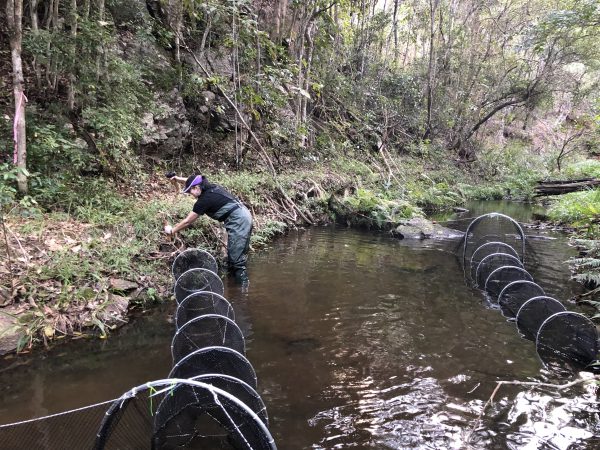9 August 2019
On-going monitoring of platypus populations using multiple survey methods will provide information vital to the conservation of this iconic species.
Recent research suggests that declines in Australia’s platypus population have been underestimated and the population may have halved since Europeans arrived.
The research on historical records[i], conducted by scientists at the University of New South Wales, indicates that in the last 10 years, platypus have not been found in 44 per cent of the sub-catchments where they were historically recorded.
The research also shows that platypus have disappeared from large areas. One significant area is the Murray-Darling Basin, and the study points to poor water management combined with a lack of water as contributing to the decrease in platypus numbers in that area.
Platypus monitoring in Queensland

Anchoring the tail end of fyke nets during a platypus survey. Image © Tamielle Brunt / Wildlife Queensland
In Queensland, it is a similar story. Wildlife Queensland’s PlatypusWatch program has responded to this historical reduction in sightings. As a result, we launched PlatyCount 2016 which investigated a reduction over 20 years in observational records within Queensland. Was this because the public was losing interest or were we losing platypus, specifically, within the greater Brisbane region where there is increasing human impact?
The funds raised from the PlatyCount 2016 campaign appeal allowed us to implement the environmental DNA (eDNA) project that Wildlife Queensland has continued for the last 4 years in this region.
eDNA is nuclear or mitochondrial DNA that is released from an organism into the environment. As part of their everyday activity, aquatic animals shed DNA from their bodies which is dispersed via water movement. The process of eDNA sampling involves collecting simple water samples and sending them for processing to a diagnostic laboratory where the DNA is then extracted if present.
In yet to be published data, we have confirmed that certain waterways within the greater Brisbane region that have historical records, no longer have platypus residing in them.
“These waterways have historical observational records but the lack of eDNA has confirmed, through repeated sampling, that platypus no longer persist there,” says University of Queensland PhD candidate and Wildlife Queensland PlatypusWatch project officer, Tamielle Brunt.
One noticeable concern Brunt observed while platypus trapping in the greater Brisbane region recently is the lack of water, causing fragmented pools.
“Even though platypus have been through drought over hundreds of years, the added human impacts would not be helping them survive,” says Brunt.
Within both urban and agricultural human-impacted areas, freshwater waterways are highly impacted upon by:
- habitat destruction – removal of vegetation, erosion, sedimentation, low water quality, stormwater runoff
- fragmentation – connections between waterways have been cut due to infrastructure (buildings, roads, weirs/dams) and lack of water, causing fragmented pools. This means platypus are forced to move out over land and risk predation
- litter entanglement – rubbish: hair ties, rubber bands, discarded fishing lines
- enclosed yabby traps
- predation by dogs, cats and foxes.
Multiple survey methods are essential
On-going monitoring using multiple survey methods (observational, eDNA, capture and tagging) will provide detailed insight into such an elusive animal’s life.
“Knowing where they are and details of population dynamics can help implement specific conservation actions,” says Brunt.
Such efforts include:
- rehabilitating appropriate waterway connections (tree planting for bank stabilisation, environmental flows)
- continuing education and community engagement to protect and keep waterways healthy
- engaging with key stakeholders (local councils and governments) to better manage development in known platypus areas
- implementing rescue strategies for small-numbered, fragmented platypus populations.
Get involved
People can help their local platypus populations by joining catchment groups (also see more information below). They implement workshops that rehabilitate banks and clean up the waterways, all helping the platypus and other species to survive.
People can also record their sightings for scientists to monitor at PlatypusWatch via email to platypus@wildlife.org.au or via the PlatypusWatch Platypus Sighting Form.
Don’t miss ‘Discovery through DNA’
Wildlife Queensland will be presenting on the practical implementation of using DNA to research and protect the platypus at EnviroForum 2019 on 22 August at the Ipswich Civic Centre.
For more information and bookings, head to the EnviroForum 2019 event page.
More information
- Find out more information about PlatypusWatch.
- Find your local Brisbane catchment group.
- Subscribe to our monthly my.Wildlife e-bulletin to stay up-to-date with Wildlife Queensland’s latest activities and projects.
[i] Hawke, T., et al. (2019). A silent demise: Historical insights into population changes of the iconic platypus (Ornithorhynchus anatinus). Global Ecology and Conservation, 20: https://doi.org/10.1016/j.gecco.2019.e00720
